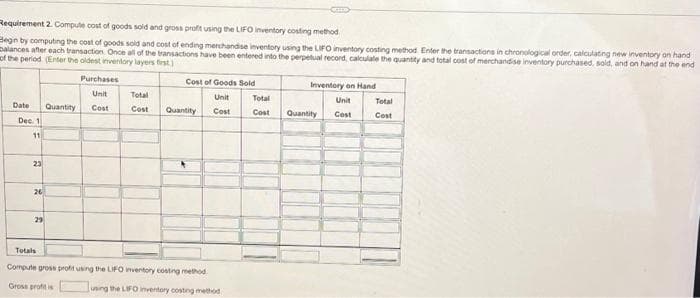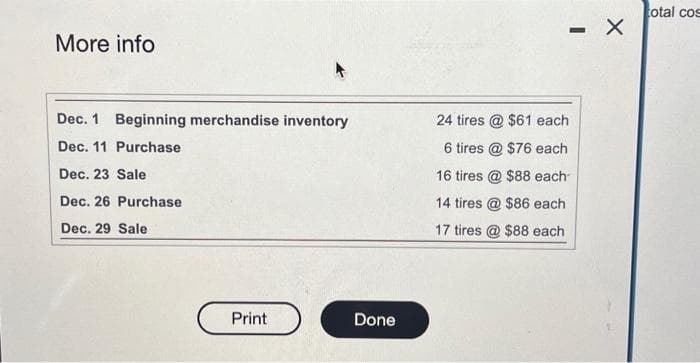More info Dec. 1 Beginning merchandise inventory Dec. 11 Purchase Dec. 23 Sale Dec. 26 Purchase Dec. 29 Sale 24 tires @ $61 each 6 tires @ $76 each 16 tires @ $88 each 14 tires @ $86 each 17 tires @ $88 each
More info Dec. 1 Beginning merchandise inventory Dec. 11 Purchase Dec. 23 Sale Dec. 26 Purchase Dec. 29 Sale 24 tires @ $61 each 6 tires @ $76 each 16 tires @ $88 each 14 tires @ $86 each 17 tires @ $88 each
Cornerstones of Financial Accounting
4th Edition
ISBN:9781337690881
Author:Jay Rich, Jeff Jones
Publisher:Jay Rich, Jeff Jones
Chapter6: Cost Of Goods Sold And Inventory
Section: Chapter Questions
Problem 44E: Perpetual and Periodic Inventory Systems Below is a list of inventory systems options. a. Perpetual...
Related questions
Topic Video
Question
Accounting

Transcribed Image Text:Requirement 2. Compute cost of goods sold and gross profit using the LIFO inventory costing method
Begin by computing the cost of goods sold and cost of ending merchandise inventory using the LIFO inventory costing method Enter the transactions in chronological order, calculating new inventory on hand
alances after each transaction. Once all of the transactions have been entered into the perpetual record, calculate the quantity and total cost of merchandise inventory purchased, sold, and on hand at the end
of the period (Enter the oldest inventory layers first)
Date
Dec. 1
11
23
26
29
Purchases
Unit
Total
Quantity Cost Cost Quantity
Cost of Goods Sold
Unit
Cost
Totals
Compute gross profit using the LIFO inventory costing method
Gross profit is
using the LIFO inventory costing method
Total
Cost
Inventory on Hand
Unit
Cost
Quantity
Total
Cost

Transcribed Image Text:More info
Dec. 1 Beginning merchandise inventory
Dec. 11 Purchase
Dec. 23 Sale
Dec. 26 Purchase
Dec. 29 Sale
Print
Done
-
24 tires @ $61 each
6 tires @ $76 each
16 tires @ $88 each-
14 tires @ $86 each
17 tires @ $88 each
X
total cos
Expert Solution
This question has been solved!
Explore an expertly crafted, step-by-step solution for a thorough understanding of key concepts.
Step by step
Solved in 4 steps

Knowledge Booster
Learn more about
Need a deep-dive on the concept behind this application? Look no further. Learn more about this topic, accounting and related others by exploring similar questions and additional content below.Recommended textbooks for you

Cornerstones of Financial Accounting
Accounting
ISBN:
9781337690881
Author:
Jay Rich, Jeff Jones
Publisher:
Cengage Learning

Century 21 Accounting Multicolumn Journal
Accounting
ISBN:
9781337679503
Author:
Gilbertson
Publisher:
Cengage


Cornerstones of Financial Accounting
Accounting
ISBN:
9781337690881
Author:
Jay Rich, Jeff Jones
Publisher:
Cengage Learning

Century 21 Accounting Multicolumn Journal
Accounting
ISBN:
9781337679503
Author:
Gilbertson
Publisher:
Cengage


Principles of Accounting Volume 1
Accounting
ISBN:
9781947172685
Author:
OpenStax
Publisher:
OpenStax College

Financial And Managerial Accounting
Accounting
ISBN:
9781337902663
Author:
WARREN, Carl S.
Publisher:
Cengage Learning,

Financial Accounting
Accounting
ISBN:
9781337272124
Author:
Carl Warren, James M. Reeve, Jonathan Duchac
Publisher:
Cengage Learning